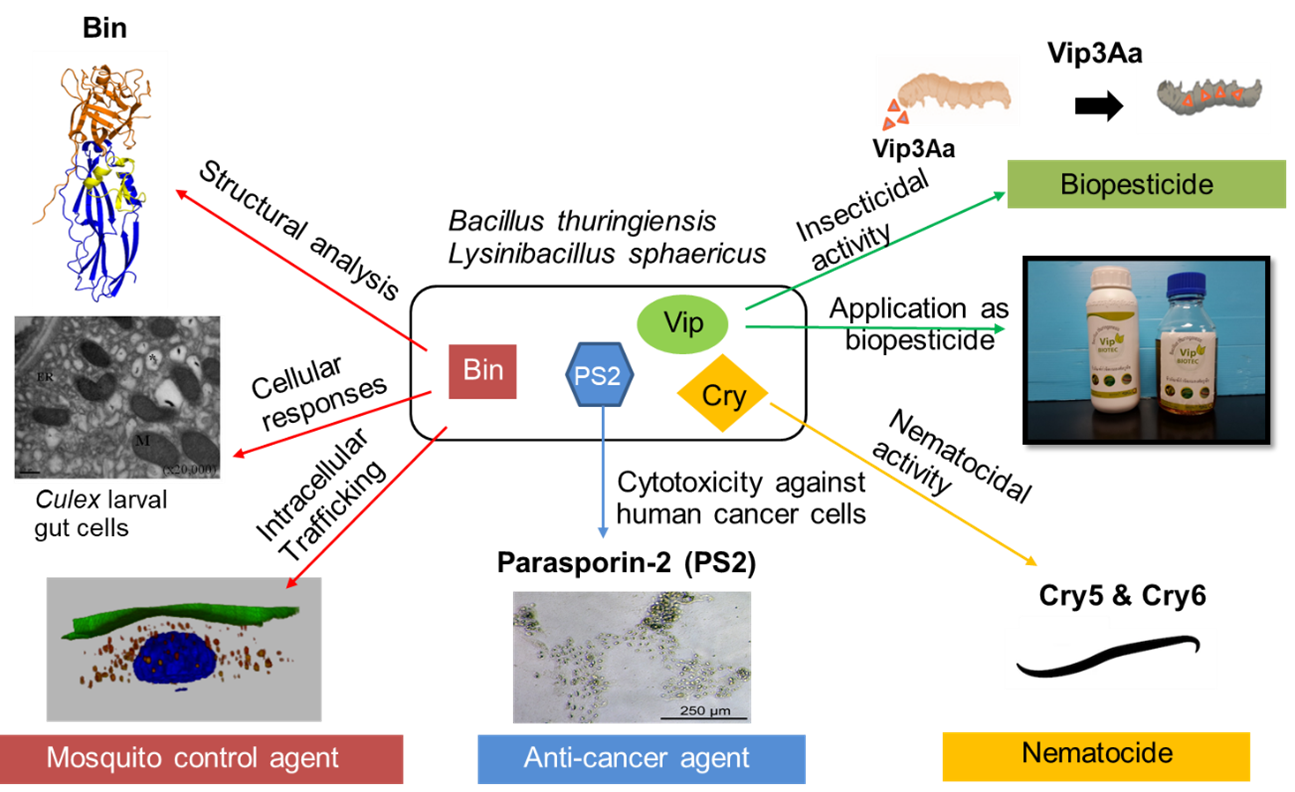Panadda Boonserm, Ph.D.
Professor
We explore molecular mechanisms and potential agricultural
and medical applications of bacterial toxins
- Tel: 66 (0) 2441-9003 – 7 Ext. 1459
- Email: panadda.boo
 mahidol.ac.th
mahidol.ac.th - Ph.D. (Biochemistry), University of Cambridge, 2002
- Academic Program(s)
Our current research focuses on the structure, function, and applications of bacterial toxins produced from Gram-positive bacteria such as Bacillus thuringiensis (Bt) and Lysinibacillus sphaericus (Ls). Some protein toxins, including Cry, Vip, and Binary (Bin) toxins, display high toxicity against a wide range of insect pests, thereby being used as topical insecticides to protect crops and prevent human diseases worldwide. In addition, certain strains of Bt also produce proteins that specifically kill human cancer cells, thus supporting an alternative application of these proteins as cancer therapeutic agents. Various strategies are required to develop bacterial toxins as biopesticides and anticancer agents to increase the effectiveness of bacterial toxins-based products. Thus, our study aims to improve the biopesticide production process to increase toxin stability, expand the host-range specificity, and delay the insect resistance against the biopesticides. Our study also aims to investigate the cytotoxic effects and intracellular responses of various human cancer cells treated with bacterial toxins to elucidate the underlying cellular mechanisms for their potential application as anti-cancer agents in the future. Besides the free toxin treatment, toxin-loaded nanoparticles and plant-derived extracellular vesicles are developed to test against human cancer cells to explore their potential application for cytotoxic enhancement and toxin delivery to kill cancer cells selectively.
1.Srisaisap M, Boonserm P. Anticancer efficacy of biosynthesized silver nanoparticles loaded with recombinant truncated parasporin-2 protein. Sci Rep. 2024;14:15544.
2.Jammor P, Sanguanphun T, Meemon K, Promdonkoy B, Boonserm P. Biosynthesis of Cry5B-loaded sulfur nanoparticles using Arthrobotrys oligospora filtrate: Effects on nematicidal activity, thermal stability, and pathogenicity against Caenorhabditis elegans. ACS Omega. 2024;9(6):6945-6954.
3.Torres J, Surya W, Boonserm P. Channel formation in Cry toxins: An Alphafold-2 perspective. Int J Mol Sci. 2023;24(23):16809.
4.Hemthanon T, Promdonkoy B, Boonserm P. Screening and characterization of Bacillus thuringiensis isolates for high production of Vip3A and Cry proteins and high thermostability to control Spodoptera spp. J Invertebr Pathol. 2023;201:108020.
5.Kumkoon T, Noree C, Boonserm P. Engineering BinB pore-forming toxin for selective killing of breast cancer cells. Toxins (Basel). 2023 Apr 18;15(4):297. doi: 10.3390/toxins15040297.
6.Kumkoon T, Srisaisap M, Boonserm P. Biosynthesized silver nanoparticles using Morus alba (white mulberry) leaf extract as potential antibacterial and anticancer agents. Molecules. 2023 Jan 26;28(3):1213. doi: 10.3390/molecules28031213.

1.Kumkoon T, Noree C, Boonserm P. Engineering BinB pore-forming toxin for selective killing of breast cancer cells. Toxins (Basel). 2023 Apr 18;15(4):297. doi: 10.3390/toxins15040297.
2.Kumkoon T, Srisaisap M, Boonserm P. Biosynthesized silver nanoparticles using Morus alba (white mulberry) leaf extract as potential antibacterial and anticancer agents. Molecules. 2023 Jan 26;28(3):1213. doi: 10.3390/molecules28031213.
3.Kanwal S, Boonserm P. Study on cellular localization of Bin toxin and its apoptosis-inducing effect on human nasopharyngeal carcinoma cells. Curr Cancer Drug Targets. 2023;23(5):388-399.
4.Romyasamit C, Saengsuwan P, Boonserm P, Thamjarongwong B, Singkhamanan K. Optimization of cryoprotectants for freeze-dried potential probiotic Enterococcus faecalis and evaluation of its storage stability. Dry Technol. 2021; doi.org/10.1080/07373937.2021.1931294.
5.Kanwal S, Abeysinghe S, Srisaisup M, Boonserm P. Cytotoxic effects and intracellular localization of Bin toxin from Lysinibacillus sphaericus in human liver cancer cell line. Toxins 2021; 13(4):288. doi:10.3390/toxins13040288.
6.Chankamngoen W, Janvilisri T, Promdonkoy B, Boonserm P. In vitro analysis of the anticancer activity of Lysinibacillus sphaericus binary toxin in human cancer cell lines. 3 Biotech 2020;10(365): doi.org/10.1007/s13205-020-02361-8.
7.Nimsanor S, Srisaisup M, Jammor P, Promdonkoy B, Boonserm P. Intracellular localization and cytotoxicity of Bacillus thuringiensis Vip3Aa against Spodoptera frugiperda (Sf9) cells. J Invertebr Pathol. 2020; Feb 7;171:107340. doi: 10.1016/j.jip.2020.107340.
8.Chooduang S, Surya W, Torres J, Boonserm P. An aromatic cluster in Lysinibacillus sphaericus BinB involved in toxicity and proper in-membrane folding. Arch Biochem Biophys. 2018; 660(12):29-35.
9.Kunthic T, Watanabe H, Kawano R, Tanaka Y, Promdonkoy B, Yao M, Boonserm P. pH regulates pore formation of a protease activated Vip3Aa from Bacillus thuringiensis. Biochim Biophys Acta 2017;1859(11):2234–2241.
10.Tangsongcharoen C, Jupatanakul N, Promdonkoy B, Dimopoulos G, Boonserm P. Molecular analysis of Culex quinquefasciatus larvae responses to Lysinibacillus sphaericus Bin toxin. PLoS ONE 2017;12(4): 0175473:e0175473.
11.Kunthic T, Surya W, Promdonkoy B, Torres J, Boonserm P. Conditions for homogeneous preparation of stable monomeric and oligomeric forms of activated Vip3A toxin from Bacillus thuringiensis. Eur Biophys J 2017;46(3):257–264.
12.Surya W, Chooduang S, Choong Y, Torres J, Boonserm P. Binary toxin subunits of Lysinibacillus sphaericus are monomeric and form heterodimers after in vitro activation. PLoS One 2016;11(6):e0158356.
- 2016 Professor M.R. Jisnuson Svasti-BMB Award for Research Excellence,
- 2014 TRF-CHE-Scopus Researcher Award in Life Sciences and Agricultural Sciences
![]()




